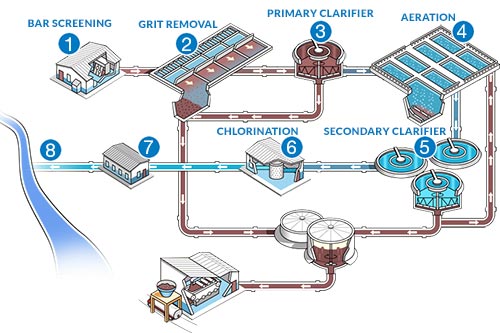Understanding Wastewater Treatment Processes and Their Environmental Effect
The details of wastewater therapy processes play a pivotal role in mitigating ecological challenges associated with water contamination. Each phase, from initial to sophisticated treatments, is developed to attend to particular pollutants, ultimately securing both public health and aquatic environments. In spite of technological improvements in therapy effectiveness, significant obstacles persist, including the management of recurring pollutants and the ramifications of nutrient runoff. As we check out the complexities of these procedures, it becomes vital to doubt how far existing techniques can progress to fulfill the growing demands of sustainability and environmental conservation.
Introduction of Wastewater Therapy
How is wastewater transformed right into a secure resource for the atmosphere? Wastewater therapy is an important process designed to eliminate impurities from used water, thereby protecting public health and wellness and shielding environments. This procedure starts with the collection of wastewater from household, commercial, and commercial sources, which is after that directed to therapy centers.
At these facilities, various physical, chemical, and organic techniques are utilized to treat the wastewater. Initial testing removes big particles, complied with by sedimentation to different heavier solids. Ultimately, biological treatments, such as turned on sludge procedures, use microorganisms to damage down natural issue. These techniques not just reduce pollutant degrees however also help with the recuperation of useful nutrients.
The dealt with effluent can be securely released into all-natural water bodies or reused for irrigation and commercial objectives, promoting source preservation. Additionally, the therapy procedure creates biosolids, which can be repurposed as plant foods or dirt changes, better improving sustainability.
Stages of Therapy Processes
The wastewater treatment procedure commonly is composed of 3 main stages: initial, main, and secondary therapy. Each stage serves a distinctive duty in reducing the pollutant load and ensuring the effluent fulfills environmental requirements prior to discharge.

The primary therapy stage concentrates on the physical separation of put on hold solids from the wastewater. With sedimentation, heavier bits settle at the end of sedimentation containers, creating sludge, while lighter products, such as oils and greases, float to the surface area and are skimmed. This process dramatically decreases the natural and not natural load in the wastewater.
Additional treatment is an organic process targeted at further reducing the concentration of raw material. Numerous techniques, consisting of triggered sludge systems and flowing filters, utilize bacteria to metabolize organic contaminants. This phase is important for attaining the necessary biochemical oxygen demand (BODY) decrease, eventually bring about cleaner effluent ready for discharge or additional treatment. Each a knockout post phase is critical in securing environmental and public wellness.

Advanced Treatment Technologies
Following the secondary therapy processes, advanced treatment modern technologies play an important duty in more boosting the top quality of dealt with wastewater. These technologies are designed try this web-site to remove residual pollutants that are not properly eliminated throughout primary and second treatments, guaranteeing the effluent meets rigid governing criteria.
Among the commonly used advanced treatment approaches are membrane layer filtration, reverse osmosis, and progressed oxidation processes. Membrane purification, consisting of microfiltration and ultrafiltration, is effective in separating fine bits, microorganisms, and colloids from the water (Wastewater). Reverse osmosis makes use of semi-permeable membranes to eliminate dissolved solids, resulting in high-grade water appropriate for numerous applications
Advanced oxidation procedures (AOPs) use strong oxidants to degrade organic toxins, including pharmaceuticals and personal treatment products that are immune to conventional treatment. These techniques enhance the biodegradability of intricate substances, facilitating their removal.
One more significant innovation is the use of biological nutrient removal procedures, which particularly target nitrogen and phosphorus, stopping eutrophication in getting water bodies. On the whole, innovative therapy modern technologies are essential for achieving higher degrees of filtration, promoting water reuse, and safeguarding public health while addressing click for source the challenges related to wastewater monitoring.
Ecological Benefits of Treatment
Various environmental benefits emerge from reliable wastewater therapy processes that contribute to ecosystem wellness and sustainability. Mostly, these processes considerably decrease the release of harmful toxins right into natural water bodies, which helps keep water communities. By removing contaminants such as heavy metals, nutrients, and virus, treated wastewater mitigates the threat of waterborne illness and promotes biodiversity in aquatic atmospheres.
Moreover, wastewater therapy centers usually use sophisticated modern technologies that allow water recycling and reuse. This practice not only saves freshwater sources but additionally reduces the need on all-natural water products. Boosted nutrient elimination from wastewater can likewise avoid eutrophication, a process that results in algal flowers and subsequent oxygen deficiency in aquatic systems.
In addition, effective therapy processes can lessen greenhouse gas exhausts, especially methane and laughing gas, which are typically launched during unattended wastewater decomposition. By catching and making use of biogas from anaerobic digesters, facilities can transform waste right into renewable resource, therefore adding to a decrease in fossil fuel reliance.
Obstacles and Future Trends
While the environmental benefits of wastewater treatment are clear, a number of difficulties persist that impede optimum results in this area. One significant issue is aging facilities, which usually results in ineffectiveness and raised operational costs - Wastewater. Numerous treatment plants were created years earlier, and their capacities do not align with modern demands, that include stricter regulatory standards and higher volumes of wastewater because of urbanization

Looking in advance, there is an expanding emphasis on source healing and circular economy principles within wastewater therapy. Advancements such as anaerobic digestion, which can produce biogas, and advanced filtration innovations are acquiring traction. These approaches not only boost therapy efficiency however also promote sustainability.
Inevitably, dealing with these obstacles requires partnership amongst stakeholders, investment in innovation, and a dedication to ongoing research. By accepting these fads, the wastewater therapy industry can progress to satisfy the needs of an altering setting and society.
Verdict
In verdict, wastewater therapy procedures play a vital role in improving environmental high quality and public wellness. The multi-stage therapy framework, paired with innovative modern technologies, properly mitigates pollution and promotes lasting water monitoring.